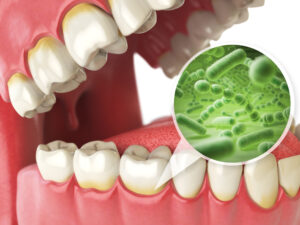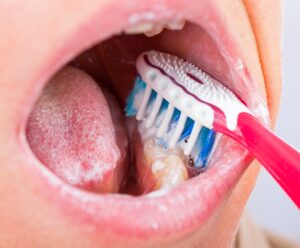How to Get Rid of Plaque on Teeth
This is a pretty commonly-googled phrase, and for good reason! Plaque is the source of cavities, gum disease and bad breath. Plaque on the teeth is bad news. If you want to have good oral health, it is important to understand how to remove it and what happens when you don’t.
What is Plaque?
 Dental plaque is the soft, white to yellowish-white buildup that accumulates on the teeth. Plaque buildup is a continual process that occurs every day in the mouth of every person. Dental plaque contains disease-causing bacteria, food debris, and cells from the tissue lining the inside of the mouth.
Dental plaque is the soft, white to yellowish-white buildup that accumulates on the teeth. Plaque buildup is a continual process that occurs every day in the mouth of every person. Dental plaque contains disease-causing bacteria, food debris, and cells from the tissue lining the inside of the mouth.
Plaque can collect anywhere inside the oral cavity, and it is very common in protected areas. The small crevice between the teeth and gums is a common hiding spot for plaque, as are the areas between two teeth.
Why is Plaque Dangerous?
Plaque itself is not dangerous, but the bacteria it contains is. They are responsible for the destruction of teeth in cavities, and the destruction of the supporting tissues of the teeth in gum disease. What many people do not realize is that both cavities and gum disease are bacterial infections!
How Plaque Causes Cavities
Certain bacteria contained in dental plaque have the ability to break down enamel, which is the hardest substance in the human body. They do this by producing a strong acid from their digestion of simple carbohydrates (sugars). Just as acid can soften and etch glass, it softens and weakens enamel, allowing those bacteria to penetrate and infiltrate the tooth. A cavity is a bacterial infection of the hard tissues of a tooth.
How Plaque Causes Gum Disease
There are also bacteria in dental plaque that cause destruction of the tissues surrounding the teeth and holding them in place. They accomplish this by producing toxins that penetrate the gum tissues. When the body detects these toxins, it sends an inflammatory reaction. At first, this inflammation is a good thing. It notifies you that something is wrong by causing redness, swelling, and bleeding in the gum.
If you ignore it, though, the inflammation transitions from good to bad, from acute to chronic. Chronic inflammation is destructive in nature, and it breaks down the attachment of the jawbone, ligaments, and gums to the teeth. This is what occurs in untreated gum disease that allows the teeth to loosen and fall out.
How Can I Remove Plaque?
Plaque removal is simple and inexpensive. The soft plaque material easily comes off the teeth with good brushing and flossing techniques. The only things required are effort and consistency. When you commit to great oral hygiene, you can save yourself the cost and frustration of dental disease.
 For good plaque removal, you must brush your teeth twice daily (preferably after breakfast as you start your day and before bedtime) using the proper technique. Technique matters because you could brush twice a day and leave lots of plaque on the teeth if your technique is wrong. A good brushing technique ensures that the toothbrush bristles touch every exposed surface of every tooth, sweeping soft plaque away in a circular motion. There is no need for hard, back-and-forth motions. Plaque is soft enough that gentle movements will remove it.
For good plaque removal, you must brush your teeth twice daily (preferably after breakfast as you start your day and before bedtime) using the proper technique. Technique matters because you could brush twice a day and leave lots of plaque on the teeth if your technique is wrong. A good brushing technique ensures that the toothbrush bristles touch every exposed surface of every tooth, sweeping soft plaque away in a circular motion. There is no need for hard, back-and-forth motions. Plaque is soft enough that gentle movements will remove it.
Flossing is also essential to good plaque removal because toothbrush bristles cannot reach into the area where two teeth meet. The best flossing technique involves wrapping the floss around each side of every tooth in a C-shape, and moving it in a vertical motion to physically scrape away any plaque adhered to the side of the teeth. If you’re unsure how this works, ask Phyllis and Nancy at your next cleaning visit for a demonstration, or search YouTube for “C-Shaped Flossing Technique”.
What if I Don’t Remove Plaque?
Plaque that remains on the teeth begins to mineralize, or harden, into a new material known as tartar or calculus. This hardened buildup is NOT removable with a toothbrush or floss, no matter what technique you use. Your dentist or dental hygienist must use specialized dental instruments to remove tartar buildup from the teeth.
Tartar carries the same risks for disease that plaque does, leading to both cavities and gum disease. Often tartar collects in locations underneath the gums where you cannot see, feel, or remove it. (You can probably smell it, though. Tartar buildup in deep pockets of the gums is a common cause of bad breath.)
When tartar collects under the gums, the only way to remove it is through a dental procedure known as scaling and root planing. Commonly called a “deep cleaning”, during scaling and root planing, your dental hygienist removes all bacterial buildup (both plaque and tartar) from the teeth, including those areas underneath the gums. The goal is to leave perfectly clean roots under the gums, to which the supporting tissues can reattach. It halts the chronic disease process and gives the body a chance to heal and rebuild.
Why Can’t I Have a “Regular” Teeth Cleaning?
 When a deep cleaning is necessary, a “regular” teeth cleaning is no longer an option. This is due to the fact that a “regular” cleaning would not remove the bacterial buildup underneath the gums, so the disease process would simply continue. In addition to not stopping the problem, performing a “regular” cleaning might give you a false sense of security that nothing is wrong, when in fact, you have ongoing gum disease.
When a deep cleaning is necessary, a “regular” teeth cleaning is no longer an option. This is due to the fact that a “regular” cleaning would not remove the bacterial buildup underneath the gums, so the disease process would simply continue. In addition to not stopping the problem, performing a “regular” cleaning might give you a false sense of security that nothing is wrong, when in fact, you have ongoing gum disease.
A “regular” teeth cleaning, officially termed a prophylaxis, falls under the category of preventive dentistry. Performing a prophy (as we dentists say) only serves to prevent gum disease; it does not treat it. When gum disease is active, the treatment necessary to stop it and return the mouth to a healthy state is a scaling and root planing.
More Questions about Plaque and Teeth Cleanings?
Call Designer Smiles today to schedule an evaluation with Dr. Ann. She can assess your current situation and discuss which type of teeth cleaning you require for prevention or restoration of good dental health.
